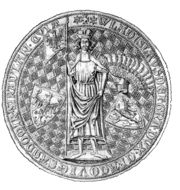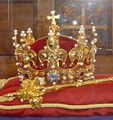Władysław I the Elbow-high
| Władysław I the Elbow-high | |
|---|---|
 |
|
| Władysław I. Drawing by Jan Matejko | |
|
|
|
| Tenure | 1320–1333 |
| Coronation | 30 January 1320 |
| Predecessor | Wenceslaus III |
| Successor | Casimir III the Great |
| Spouse | Hedwig of Kalisz |
| Issue | |
| Kunigunde, Duchess of Świdnica Casimir III of Poland Elizabeth, Queen of Hungary |
|
| House | House of Piast |
| Father | Casimir I of Kuyavia |
| Mother | Euphrosyne of Opole |
| Born | 1261 |
| Died | 2 March 1333 Kraków, Poland |
| Burial | Wawel Cathedral, Kraków |
Władysław the Short or Elbow-high (or Ladislaus I of Poland, Polish: Władysław I Łokietek; 1261 – 2 March 1333), was a King of Poland. He was a Duke until 1300, and Prince of Kraków from 1305 until his coronation as King on 20 January 1320.
Contents |
Royal titles
- Title before coronation: Wladislaus Dei gracia, dux Regni Poloniae et dominus Pomeraniae, Cuiavie, Lanciciae ac Siradiae
- Royal title after coronation: Wladislaus Dei gracia, rex Poloniae et dominus Pomeraniae, Cuiavie, Lanciciae ac Siradiae
Later histories refer to him also as Władysław IV or Władysław I. There are no records to show that he actually used any regnal number. Both numerals are retrospective assignments by later historians. IV comes from him being the fourth of that name to rule as overlord of the Polish, since Władysław I Herman. It comes from him having restored the monarchy after a fragmented era of a century or more, and also backwards-counting from Władysław of Varna who officially used III and Władysław Vasa who officially used IV.
Biography
In 1138, the kingdom of Poland, which had been growing in strength under the rule of the Piast dynasty, encountered an obstacle which impeded its development for nearly two hundred years. In the will of King Bolesław Krzywousty, Poland was divided into five provinces – Silesia, Mazovia with Cuiavia, Greater Poland, the part of Pomerania around the City of Gdańsk, the Sandomierz Region, and Lesser Poland, the 'senior palatinate', comprising the areas around Kraków, Łęczyca, and Sieradz. To prevent his four sons from quarrelling, Boleslaus granted one province to each of them, and the fifth one, the senior palatinate, was to be given to the eldest brother on the grounds of primogeniture. The reason for such a decision was not only to forestall dynastic feuds, but also to prevent the disintegration of the kingdom. However, it proved an inadequate solution, and started nearly two centuries of what it had sought to counteract – constant fighting and disorder. Władysław succeeded in re-uniting the Kingdom of Poland.
Wladyslaw was born circa 1260 as the third son of Kazimierz I Kujawski, Duke of Łęczyca, Sieradz and Cuiavia. After the death of his father, he inherited Cuiavia, while the remaining two duchies went to his brothers, Leszek Czarny (the Black) and Kazimierz II of Łęczyca. However, following the deaths of both brothers, the entire inheritance passed to Władysław, who began the task of re-uniting the Kingdom of Poland. His next step was to win Lesser Poland, for which he had to contest the local prince, Przemysł II. Following Przemysł death in 1296, Wladyslaw proclaimed himself his successor and established himself in Lesser Poland, as well as in Pomerania. While Władysław enjoyed the support of the Lesser Polish peasants, knights and part of the clergy who preferred a prince from the domestic Piast dynasty, he had to defer to Václav II of Bohemia, who had the support of the local lords. In 1304 Władysław entered and occupied Lesser Poland with an army of his supporters, which, according to the 15th-century historian Jan Długosz, consisted of more peasants than knights. He also conquered Pomerania around Gdańsk, but since he did not win the favour of the local lords and settlers from Brandenburg who had migrated to that area, he was forced to give up the idea of complete control of the Baltic coast.

By 1311, Władysław was already in power in Lesser Poland and his Cuiavian patrimony. Despite a rebellion by the German patricians of Kraków and Sandomierz, he was able to hold these cities thanks to the support of the nobility, gentry and townsfolk. Three years later, Greater Poland also came under his rule. However, John of Luxemburg, King of Bohemia, also claimed the succession to the Polish crown. In alliance with the Teutonic Order, he attacked Władysław's forces from the north and west, while the Brandenburgians attempted to capture Greater Poland. Nonetheless, Władysław managed to maintain his dominions.
In 1318, he embarked on a coronation campaign. The pope, though initially unwilling, finally granted his approval and Władysław was crowned King of Poland on 30 January 1320 in Kraków. The coronation was a sign that he had overcome Poland's internal fragmentation and re-united and re-instated the country as an independent kingdom under his rule.
A Polish-Teutonic War (1326–1332) occupied Władysław's last years. In 1331, 27 September in Kuyavia near Radziejów fought the Battle of Płowce against a group of Teutonic knights. Other groups of enemies withdrew to the north. After numerous casualties the armies were stalemated, though Władysław's forces conquered the field, captured some prisoners and stopped the expansion of the Teutonic Order in the region.
Władysław endeavored to establish a uniform legal code throughout the land. With the general laws he assured the Jews safety and freedom and placed them on equality with the Christians.
Władysław died on 2 March 1333 in Kraków. Although his son, Casimir III the Great, inherited only Lesser Poland, the Duchy of Sandomierz, Greater Poland, Cuiavia, and the Duchies of Łęczyca and Sieradz; while Silesia and the Land of Lubusz to the west, along with Gdańskian Pomerania, Western Pomerania, and Mazovia the north remained beyond the Kingdom's borders, Władysław's reign was a major step on the road to restoration of the Kingdom of Poland.
In historic Poland, an ell was a measure of length. 1 ell equalled 0.78 metres. Due to his short stature, the king was nicknamed 'Łokietek', which is a diminutive of the word 'łokieć' (ell, elbow).
Marriage and children
In 1293, Władysław married Hedwig of Kalisz.[1] She was a daughter of Boleslaus of Greater Poland and Jolenta of Hungary. They had six children:
- Stephen of Poland (d. 1306).
- Władysław of Poland (d. 1311/1312).
- Kunigunde of Poland (c. 1298 – 9 April, 1331). Married first Bernard of Świdnica. Their children included Bolko II of Świdnica. Married secondly Rudolf I, Elector of Saxony.
- Elisabeth of Poland (1305 – 29 December, 1380). Married Charles I of Hungary.
- Casimir III of Poland (30 April, 1310 – 5 November, 1370).
- Hedwig of Poland (d. 3 June, 1320/1322).
Ancestors
|
|
|
|
|
|
|
|
|
|
|
|
|
|
|
|
|
Casimir II of Poland | ||||||||||||
|
|
|||||||||||||
|
|
|
|
|
|
|||||||||
|
|
Konrad I of Masovia |
|
|||||||||||
|
|
|||||||||||||
|
|
|
|
|
|
|
|
|
||||||
|
|
Helen of Znojmo | ||||||||||||
|
|
|||||||||||||
|
|
|
|
|
|
|||||||||
|
|
Casimir I of Kuyavia |
|
|||||||||||
|
|
|||||||||||||
|
|
|
|
|
|
|
|
|
|
|
|
|||
|
|
Svyatoslav III Igorevich | ||||||||||||
|
|
|||||||||||||
|
|
|
|
|
|
|||||||||
|
|
Agafia of Rus |
|
|||||||||||
|
|
|||||||||||||
|
|
|
|
|
|
|
|
|
||||||
|
|
Iaroslava Riurikovna of Kiev[2] | ||||||||||||
|
|
|||||||||||||
|
|
|
|
|
|
|||||||||
|
|
Władysław I the Elbow-high |
|
|||||||||||
|
|
|||||||||||||
|
|
|
|
|
|
|
|
|
|
|
|
|
|
|
|
|
Mieszko I Tanglefoot | ||||||||||||
|
|
|||||||||||||
|
|
|
|
|
|
|||||||||
|
|
Casimir I of Opole |
|
|||||||||||
|
|
|||||||||||||
|
|
|
|
|
|
|
|
|
||||||
|
|
Ludmila (of Bohemia?) | ||||||||||||
|
|
|||||||||||||
|
|
|
|
|
|
|||||||||
|
|
Euphrosyne of Opole |
|
|||||||||||
|
|
|||||||||||||
|
|
|
|
|
|
|
|
|
|
|
|
|||
|
|
? | ||||||||||||
|
|
|||||||||||||
|
|
|
|
|
|
|||||||||
|
|
Viola, Duchess of Opole |
|
|||||||||||
|
|
|||||||||||||
|
|
|
|
|
|
|
|
|
||||||
|
|
? | ||||||||||||
|
|
|||||||||||||
|
|
|
|
|
|
|||||||||
Gallery
 The so-called Crown of Bolesław the Brave was made for Władysław I.[3] |
In 1320 the King started the building of a new Wawel Cathedral.[4] |
Władysław the Elbow-high Tomb effigy in the Wawel Cathedral. |
See also
- History of Poland (966–1385)
References
- ↑ Profile of Władysław in "Medieval Lands" by Charles Cawley
- ↑ www.aemyers.net
- ↑ Rożek Michał, Polskie koronacje i korony, Kraków 1987. ISBN 8303019147
- ↑ Kraków, Małgorzta Woszczenko
External links
|
Władysław I the Elbow-high
Born: 1260/61 Died: 2 March 1333 |
||
| Royal titles | ||
|---|---|---|
| Preceded by Wenceslaus III |
King of Poland 1320–1333 |
Succeeded by Casimir III the Great |
|
||||||||||||||||||||||||||